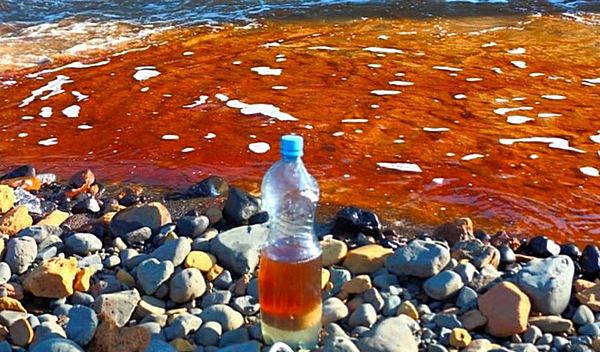
It was an ordinary hot summer day. There are many of them when you are working, and for some reason, very few when you have a day off. The quarantine at the Research Institute of Heat and Cold (NIITiHo) fell into a Z state. The main engineering staff has long been working in the field, only IT specialists, for the most part, worked remotely. Engineer Samsonov listlessly poked with a screwdriver in some ancient printed circuit board, trying to either revive it, or finally ditch it. Lunch ended an hour ago, and it was still infinitely long before the end of the working day.
Suddenly a group of alarmed laboratory assistants ran past him and, exclaiming indignantly, disappeared around the corner of the corridor. The sleepy mood instantly flew away from Comrade Samsonov. He cheerfully shook his head around and noticed the same engineers waking up like mushrooms after a mushroom rain. Quiet interrogative conversations flowed through the room. Nobody knew what was going on.
Suddenly a stern stomp was heard and Gosha Kucherenko's department in full force swept along the corridor. They were usually responsible at the institute for unexpected incidents. There were legends that they created them themselves, and then with heroic efforts overcame them and received prizes, medals and praise from the leadership for this. In general, on the one hand, they did not seem to be very much loved, on the other hand, this foreshadowed an interesting development of events.
And then Samosonov's subtle nose sensed something was wrong. The smell of fuel hit my nose. Samsonov took a deep breath and pondered, analyzing its spectral composition ... Not gasoline, although it looks like ... Definitely not gas. Maybe a diesel? But from where? NIITiHo has long been equipped with wind generators and its own mini-hydroelectric power station. The diesel generator was decommissioned and dismantled two years ago, because there were too many problems with it, and the low carbon footprint and the required level of energy efficiency were not achieved categorically with it.
The result of the analytical work flew into Samsonov's head like lightning and he cracked himself on the forehead with his fist, which still had a screwdriver. Shrinking from unpleasant sensations, he rushed like a bullet to the window, where there were practically no empty seats. But on the street everything was calm. Then Samsonov ran to the office opposite, from which he had the keys. The windows were clear there, and he clung to the glass, looking for the old diesel jeep Zavlaba, on the rear window of which flaunted the proud inscription "F ** K FUEL ECONOMY". I must say that the head's jeep stood in a separate place in the shade. It was forbidden to park cars next to him. Around the proud black giant, a yellowish liquid spread rather quickly, which gave off red in the rays of the high-standing sun.
Kucherenko's team famously circled around the spot, but the effectiveness of this process was extremely low. Zavlab himself stood in the distance and smoked sadly, looking at what was happening. On the one hand, it was high time to change this gluttonous monster for a more efficient specimen, but something kept getting in the way. On the other hand, he feared the consequences of this accident. A hundred liters from the tank into your own river from the mini-hydroelectric power station. They certainly won't pat him on the head for this ...
The other day it has been 2 months since the ecological disaster occurred in Norilsk, the consequences of which are still being eliminated.
Actually, on the topic
On May 29, 2020, 21,163 tons of diesel fuel, the backup fuel of Norilsk CHPP-3 (the main fuel is gas), poured into the soil.
Mini information on CHP-3
-3 1976–1986 . «- », « « ». -3 . .
Diesel got into the Ambarnaya River, which flows into Lake Pyasino, from which flows the Pyasina River, which flows into the Pyasinsky Bay of the Kara Sea, which, in turn, is part of the Arctic Ocean.
Thus, very serious damage was caused to nature, and this accident once again showed the problems of a prompt response and organization of the process of preventing such situations at industrial facilities in Russia.
To show the severity of the disaster (21163 tons is even scary to imagine), we at NIITiKho decided to calculate what benefits the lost diesel fuel could bring.
- This volume of fuel would be enough for 20% of the annual electricity and heat generation at Norilsk CHPP-3. This is 2.5 months of non-stop work.
- 1 ₽ ( - - ). 10 148 .
- ( , , ), 400 *.
This is the consumption of the entire Kaliningrad region for a month. Or the city of Sevastopol for 2 months. And this is together with the industry.
If we consider only households, then it would be possible to supply electricity to approximately 133 thousand households or 300 thousand people (depending on the region) during the year.
If this diesel engine could fill the car (of course, it is not worth it with heating oil), then with an average consumption of 20 liters per 100 kilometers, this fuel could drive 125 million kilometers. This is comparable, for example, with the distance to the nearest planets of the solar system - Mars or Venus. Or 311 distances from the Earth to the Moon. Or 3100 times around the Earth.
This is how we lose useful energy and, even worse, cause additional harm to ourselves and the planet.
And in order not to end on a sad note, I would like to say that everything is in our hands. You need to use energy consciously and develop steadily. And everyone will be environmentally friendly, warm and good.
NIITiKho asset.
Several photos from the crash site




. , .




. , .